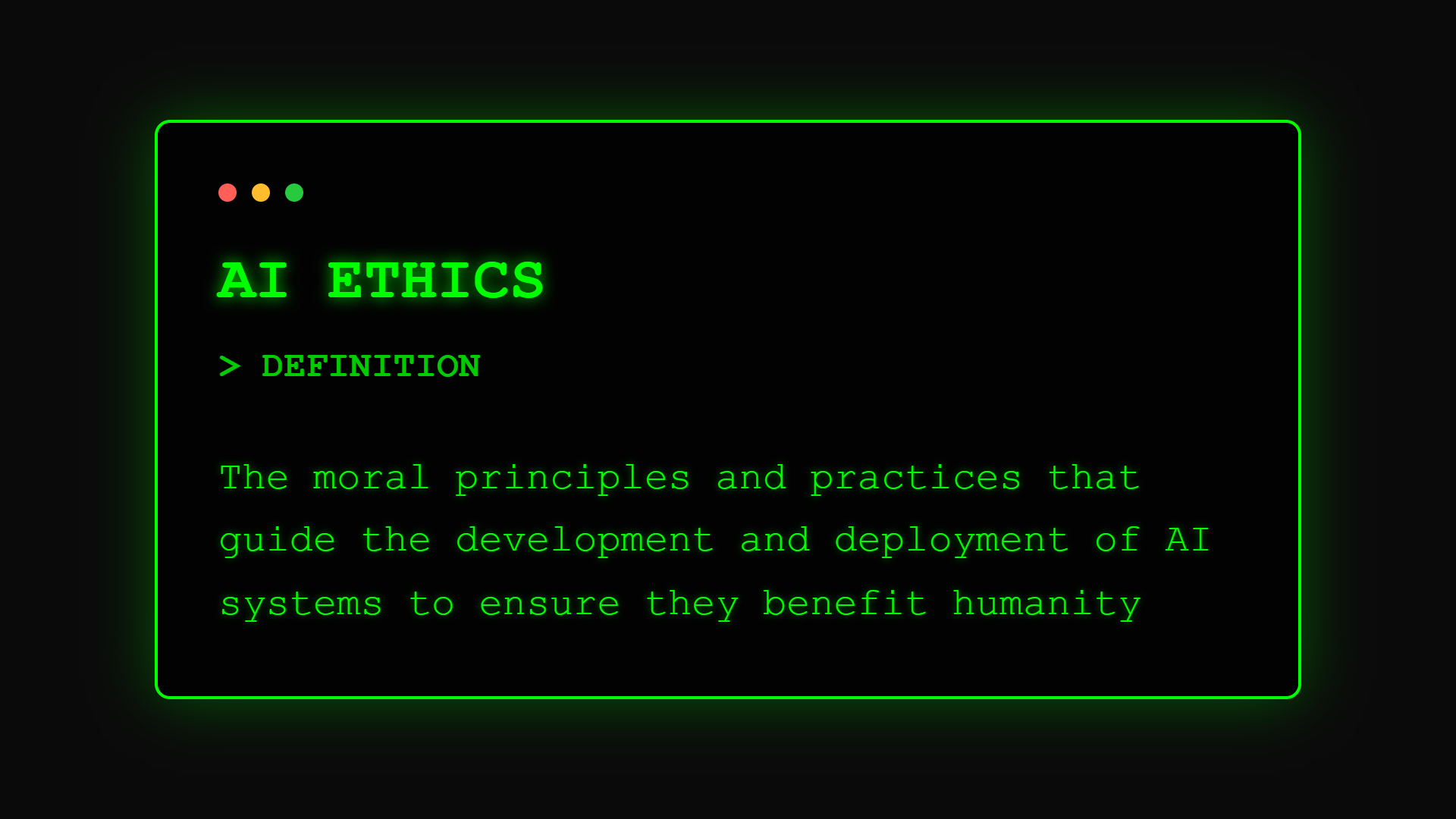AI Terms
What is AI Ethics? The Moral Compass for Machine Intelligence

Your AI makes millions of decisions daily – about customers, employees, and operations. Each decision reflects your company's values. AI ethics ensures these automated decisions align with human values, legal requirements, and social responsibility, protecting both your business and society.
Defining AI Ethics
AI ethics is the branch of ethics that examines the moral implications of artificial intelligence, establishing principles and practices for responsible AI development and deployment. It addresses questions of fairness, accountability, transparency, privacy, and human welfare in AI systems.
According to the IEEE's Ethically Aligned Design framework, AI ethics encompasses "the values and principles that guide the design, development, and deployment of autonomous and intelligent systems to ensure they respect human rights and well-being."
The field emerged as AI's societal impact grew, with landmark incidents like biased hiring algorithms and facial recognition failures highlighting the need for ethical guardrails.
Business Imperative
For business leaders, AI ethics isn't about philosophy – it's about sustainable competitive advantage through trustworthy AI that enhances reputation, ensures compliance, and builds lasting customer relationships.
Think of AI ethics as quality control for decision-making. Just as you wouldn't sell unsafe products, you shouldn't deploy AI that could harm users, discriminate unfairly, or violate privacy. Ethical AI is simply good business.
In practical terms, this means building AI systems that customers trust, regulators approve, employees support, and society accepts – avoiding the headlines that destroy brand value overnight.
Core Ethical Principles
AI ethics rests on these pillars:
• Fairness & Non-discrimination: Ensuring AI treats all individuals and groups equitably, avoiding bias that disadvantages protected classes
• Transparency & Explainability: Making AI decisions understandable to stakeholders, enabling accountability and trust
• Privacy & Security: Protecting personal data throughout the AI lifecycle, respecting user consent and data rights
• Human Agency & Oversight: Maintaining meaningful human control over AI systems, especially for high-stakes decisions
• Beneficence & Non-maleficence: Ensuring AI benefits humanity while preventing harm, considering long-term societal impacts
Ethical Challenges in AI
Key dilemmas businesses face:
Accuracy vs. Fairness: Optimizing for overall accuracy may disadvantage minorities – like medical AI performing worse on underrepresented populations
Personalization vs. Privacy: Better service requires more data, but excessive collection violates privacy expectations
Efficiency vs. Employment: AI automation improves efficiency but may displace workers, requiring careful transition planning
Innovation vs. Safety: Rapid deployment captures market advantage but may introduce unforeseen risks
These tensions require thoughtful balance rather than absolute solutions.
Ethical Frameworks
Major approaches to AI ethics:
Framework 1: Rights-Based Focus: Fundamental human rights Principle: AI must respect dignity and rights Example: EU's rights-centric AI regulation
Framework 2: Utilitarian Focus: Greatest good for greatest number Principle: Maximize overall benefit Example: Public health AI optimizing population outcomes
Framework 3: Virtue Ethics Focus: Character and values Principle: AI should embody virtues Example: Customer service AI demonstrating empathy
Framework 4: Care Ethics Focus: Relationships and responsibility Principle: Consider vulnerable stakeholders Example: Elder care AI prioritizing human connection
Real-World Ethics Applications
Companies leading ethical AI:
Technology Example: Microsoft's AI ethics committee rejected a facial recognition contract with law enforcement due to civil liberties concerns, choosing principles over profit and strengthening their brand as an ethical leader.
Healthcare Example: Mayo Clinic's AI development includes patient advocates in design phases, ensuring AI tools respect patient values and cultural differences, resulting in higher adoption and better outcomes.
Financial Example: Mastercard's AI ethics framework requires all AI models to pass fairness testing before deployment, preventing discriminatory lending while maintaining profitability and regulatory compliance.
Implementing AI Ethics
Practical steps for ethical AI:
Governance Structure:
- Ethics review board with diverse stakeholders
- Clear escalation paths for ethical concerns
- Regular ethics training for all teams
Development Practices:
- Ethics-by-design methodology
- Diverse and inclusive teams
- Regular bias and fairness testing
Deployment Standards:
- Staged rollouts with monitoring
- Clear opt-out mechanisms
- Transparent communication
Continuous Improvement:
- Regular ethics audits
- Stakeholder feedback loops
- Public transparency reports
Common Ethical Pitfalls
Mistakes to avoid:
• Ethics Washing: Superficial ethics statements without substantive action → Solution: Concrete metrics and accountability
• Ethics as Afterthought: Adding ethics review after development → Solution: Integrate ethics from project inception
• Narrow Perspective: Ethics decisions by homogeneous teams → Solution: Diverse stakeholders in ethics processes
• Static Approach: One-time ethics review → Solution: Continuous monitoring and adaptation
Building Ethical AI Culture
Your path to responsible AI:
- Understand Bias in AI to prevent discrimination
- Implement Explainable AI for transparency
- Establish AI Governance structures
- Read our AI Ethics Implementation Guide
Part of the [AI Terms Collection]. Last updated: 2025-01-11